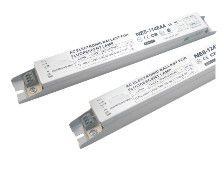Home »
FAQs » What is the Difference Between Rapid Start ballast and Instant Start?
What is the Difference Between Rapid Start ballast and Instant Start?
2014-04-05 14:52:01
Rapid-start electronic ballasts have a separate set of windings which provide a low voltage (approx. 3.5 volts) to the electrodes for one second prior to lamp ignition. A starting voltage somewhat lower than that of instant ballast (typically 405-550V for F32T8 lamps) is applied, striking an electrical arc inside the lamp. Most rapid-start electronic ballasts continue to heat the electrode even after the lamp has started, which results in a power loss of 1.5 to 2 watts per lamp. Lamps operated by a rapid-start electronic ballast will typically withstand 15-20K switch cycles. Rapid-start ballasts are typically wired in series. This means that if one lamp fails, all other lamps in the circuit will extinguish.Rapid start ballast apply a low filament voltage to preheat the cathodes. Simultaneously, a starting voltage (lower than that used in instant start) is also applied to strike the arc. When the cathodes are hot enough, the lamp will strike. The filament voltage continues to be applied throughout the operation of the lamp. Rapid start ballasts appear to have a slight turn on delay compared to instant start. They will typically not be able to start lamps reliably under 50 degrees F.
Instant start ballast apply high voltage across the lamp with no preheating of the cathode. THIS IS THE MOST ENERGY EFFICIENT starting method for fluorescent lamp ballasting. I.S. ballast use 1.5 to 2 watts less per lamp than rapid start ballast. Other I.S. ballast benefits typically include parallel lamp circuitry, (ballast wired with parallel lamp circuitry is what allows other lamps to continue burning when one or two go out without damage to the ballast or lamp), longer remote wiring distance, easier installation due to less complicated wiring, and capability to start lamps at 0 degrees F versus 50 degrees for rapid start.
Instant-start electronic ballasts are the most popular type of electronic ballast today because they provide maximum energy savings and they start lamps without delay or flashing. Since they do not provide lamp electrode heating,
fluorescent ballast consume less energy than comparable rapid-start, program rapid-start or programmed-start ballasts. As a result, they provide the most energy efficient solution to fluorescent lamp ballasting. The instant-start ballast uses 1.5 to 2 watts less energy per lamp than the rapid-start alternative.
Instant-start electronic ballasts provide a high initial voltage (typically 600V for F32T8 lamps) to start the lamp. This high voltage is required to initiate discharge between the unheated electrodes of the lamp. However, the cold electrodes of lamps operated by an instant-start ballast may deteriorate more quickly than the warmed electrodes of lamps operated by a rapid start, program rapid-start or programmed-start ballast. Lamps operated by instant start ballasts will typically withstand 10-15K switch cycles. Instant-start ballasts and typically wired in parallel. This means that if one lamp fails, the other lamps in the circuit will remain lit.
